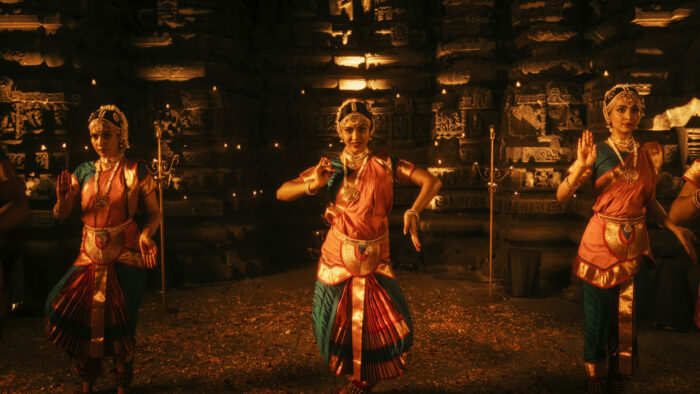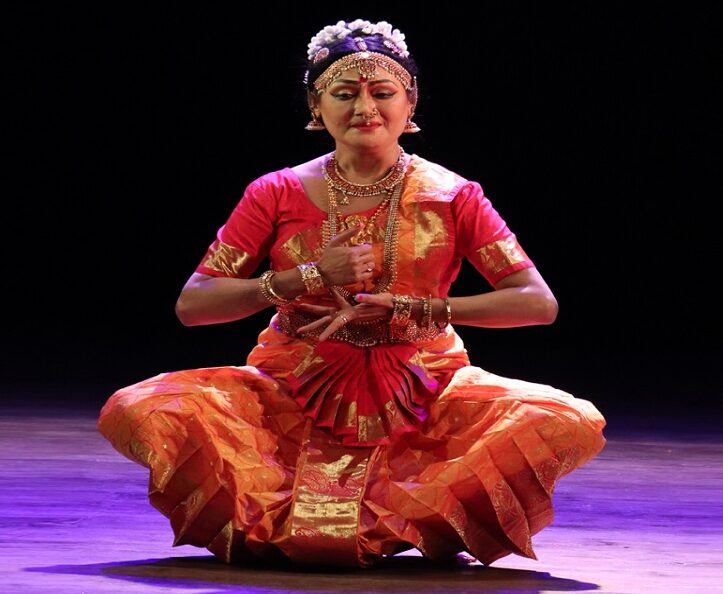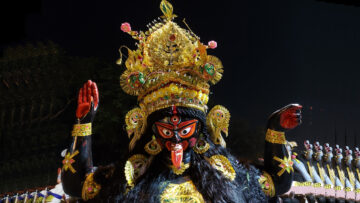Tantra, understood as “Tanu vistāre” represents the profound expansion of our embodied consciousness. This expansion aims to recognize the unity of the individual self (ātmān) with the Supreme Being (Paramātmān). In this intricate philosophy, we realize that our personal identity, the embodied ego, is not isolated but intricately interwoven with the divine essence. What exists within our physical form (deha-bhānda) is also mirrored in the vastness of the cosmos (brahmānda). Thus, the transformative journey of tantra embarks on a quest to bridge the gap between the microcosm of our individual selves and the macrocosm of the universe.
The highest state of existence is known as “anuttara” which is the harmonious merging of consciousness and creative force, a wondrous play where the divine embraces the individual, allowing the universe to unfold in its magnificent splendor. This is represented by the inseparable union of Śiva and Śakti. In this divine symbolism, Śiva, the embodiment of pure consciousness, experiences the very essence of oneself as Śakti. Śakti, in turn, is a reflective awareness, a profound blissful state, showcasing the supremacy of the self. This bliss, ānanda, is akin to a delightful artistic experience, where the entire creation bursts into radiant existence. Its intensity is such that it overflows, projecting an “other” as a counterpart, to experience oneself fully. This beautiful process of descent sees the Supreme Paramaśiva taking on the form of individual jivas, each to relish the divine play, the cosmic dance of existence.
Śiva, assumes the role of the nartaka, the dancer or actor, within the grand drama of existence. He orchestrates his own nātāka, the cosmic play, where he embodies the raṅga mañca, the very stage on which this divine spectacle unfolds. Simultaneously, he expands his being to encompass the entire cosmos, while also concealing his true nature through his own inherent power, projecting the wondrous diversity that surrounds us. This intricate interplay is captured in the sūtra, raṅgo-antarātmā, where Śiva, as the cosmic actor, conceals his essence within the cosmos.
In this expansive display, he assumes numerous forms, and his śaktis, the divine energies personified as the karaṇeśvarī-s, partake in this grand performance. They, in turn, experience this divine play through the senses, acting as both the audience and participants, revealed in the Śiva sūtra-s as prekṣakaṇi indriyāni. This beautifully orchestrated interplay of creation and perception is the essence of the cosmic drama, where the supreme consciousness dances as both the creator and the creation itself.
In this intricate cosmic dance, the word “nartaka” resonates with multiple meanings. It embodies the roles of both an actor and a dancer. Yet, in the grand play of existence, it is Śiva who is the true actor, beautifully portraying the individual self, while the antrarātma, the inner soul, is none other than Śiva, expanding as the boundless cosmos itself. This has been expressed beautifully as being the parts of performance. The āṅgika is the cosmos, vācika is all the forms of speech and mental modes, the celestial bodies as the ornaments or āhārya, and the subtlest sātvika as Śivam. The pinnacle of this pursuit is the ultimate liberation, the state where one transcends the boundaries of the individual self to witness the seamless unity with the cosmos. To dance in harmony with the cosmic rhythm, to experience the profound oneness with the universe, is the culmination of the dancer’s quest. It is in this divine realization that the dance of life and the dance of the universe converge, unveiling the timeless truth of existence, and the liberation that lies in recognizing this profound oneness.
The concept of identifying the dancer’s art with the cosmic dance of Śiva indeed faces challenges. At its core, dance embodies a graceful synchronization of movements, a beautiful expression of the human form. However, the reality is that dance, at times, gets vulgarized, losing touch with its inherent divinity. It can become a mere vehicle for the intensification of worldly pleasures, distancing itself from its spiritual essence.
In the past, societal taboos led to the stigmatization of “nautch girls,” illustrating how dance was sometimes perceived negatively within elite circles. Not all forms of dance are inherently dedicated to the divine, and not all movements within dance can be immediately equated to the cosmic movements of Śiva. This raises the crucial question: how can the mundane, which often appears detached from spirituality, become a pathway to the highest state of experience and eventual liberation?
The nartaki, the female dancer, is revered as one of the kula nāyikā-s in āgama-s, emphasizing her significance in traditional scriptures. The nātyā-śāstra, regarded as the fifth Veda, amalgamates elements from the four Vedas, ensuring that the essence of dharma perseveres in the challenging era of Kali Yuga.
The core challenge remains the objectification of dance. When dance is treated as a mere object, detached from the self, it loses its vitality and connection with the essence of the Self. This detachment leads us to neglect the fundamental truth that the Self drives every movement, often focusing solely on the external, superficial aspects of the dance. In doing so, we risk severing the profound spiritual force that dance has the potential to embody. The act of witnessing a dance performance carries immense benefits, akin to that of a yāga (sacred ritual), highlighting the transformative power of this art. The joy derived from an aesthetic experience is likened to the bliss born from the state of Brahman realization, suggesting that dance once held a divine aspect, even though it has been subject to vulgarization over time.
This disconnect from the essence of the Self results in a loss of consciousness, diminishing dance to a level of vulgarity. Our failure to recognize the deeper significance within the dance removes the sense of mindfulness and reverence that should be an integral part of this art form. It is as if the dance, stripped of its spiritual essence, becomes a mere platform for the mundane and material, devoid of its true life and vitality. Thus in order to counter this, it is crucial to reconnect with the inner Self, to understand that every movement in dance is a reflection of the divine force within us. By acknowledging the sacredness of each gesture, we restore the life and soul of dance. This recognition, pratyabhijñā, restores our consciousness, making dance a vessel for spiritual expression and inner harmony.
Indeed, the recognition of the deeper, non-dual aspect of dance often occurs through an evolutionary process. In the realm of objectivity, there exists duality, a separation between the dancer and the dance. However, the true essence lies in the realm of the Self, which is inherently non-dual, representing a state of unity and oneness. Similarly, in the journey of dance, one progresses from the mundane (aparā) to the subtle (parāparā) and finally to the supreme (parā). At each stage, the experience of the performance undergoes a transformation. Initially, the dancer may be caught up in the external aspects, the technicalities, and the material aspects of the dance (aparā). As the journey deepens, the focus shifts to the subtler nuances, the emotional and artistic expression (parāparā). But the ultimate goal is to transcend these levels, to move beyond the confines of the external and the subtle, and to touch the realm of the supreme (parā). Here, the dancer experiences the unity of all aspects, merging with the dance, the audience, and the divine essence. It’s a state where the boundaries dissolve, and the oneness is realized.
This evolution in the experience of dance mirrors the spiritual journey, where we move from the material and the external to the profound recognition of the non-dual, the unity that underlies all existence. It’s a beautiful process of realization and transformation, where dance becomes a medium not just for artistic expression but for the discovery of our innate connection with the cosmos.
(Figure 1: A still from Smt. Nandita Banerjee’s Dance Performance)
Now let us elaborate on these aspects:
Aparā : Ānāvopāya : Kriyā Śakti : Paśu Bhāva
We start with the mundane, the gross state known as the aparā state. In this stage, the effort is primarily physical, and the influence of the mala-s (coverings or limitations) is pronounced. To facilitate even the slightest experience, ānavopāya, the path of small means, is introduced. Here, “ānava” signifies small or subtle methods of practice. At this initial stage, the dancer begins their journey. They may be predominantly identified with the physical body, with dance serving as a sequence of movements for pleasure or entertainment. This is the realm where the dance might lack deeper spiritual significance, as the focus remains on the external aspects.
However, as the mundane mind encounters the touch of grace, something transformative occurs. The dancer starts to experience the first taste of bliss, a glimpse of the divine essence that resides within the art. This newfound experience kindles a curiosity, a thirst to understand and connect with the divine at a deeper level.
This transition serves as the turning point, where the dancer begins to perceive dance as more than just a physical act. It becomes a mode of worship, a sacred offering to the divine. The dancer understands that through the art, they can communicate with the divine, expressing devotion and reverence through the graceful movements of the body. The act of dancing, once primarily driven by pleasure, now evolves into a spiritual practice, a means of devotion, and an offering to the divine. This elevation of dance from the mundane to the sacred is a beautiful transformation, fueled by the dancer’s growing awareness and the touch of grace that opens the gateway to the divine. It signifies the beginning of a profound journey, where each movement becomes a tribute, a celebration of the divine presence, and a path of devotion leading to the higher realms of consciousness.
This initial stage represents the first bhāva in tantra, a foundational step in the journey. Here, the individual perceives the deity as separate, the divine is often seen as the Queen of Cosmos or the Divine Mother, and the individual identifies themselves as the child of this divine entity. While there exists devotion in this stage, it does not lead to the realization of non-duality, resulting in a noticeable presence of puritan behavior. In this dualist framework, certain limitations persist. For example, practitioners may view other deities as distinct manifestations or perceive them as lesser than the chosen deity. There might be an overemphasis on ācāra-s (rituals and conduct), sometimes leading to excessive rigidity. This phase signifies an important step on the path, but it is not the ultimate or final state.
Parāparā : Śāktopāyā : Jñāna Śakti : Vīra Bhāva
At this stage, the dancer transcends the initial dualistic separation and gains a deeper understanding of the interconnectedness of all aspects of existence. The divine is no longer perceived as separate, but rather as an integral part of the dancer’s being. The expression also involves visualising the divine as more than a divine individual. This same divine can become the social aspect, empowering us or could become the very force which brings the movements to life.
Since the parāpara is focused over the intellect, a dancer delves into dance as a mode expression which is beyond simple bodily movements. The body, however is a primary criterion for dance, but the body also has its own language of expression. The choreography evolves to express subtler aspects much more clearly. And dance becomes a language.
Just as in any act of speech, the speaking agent is inevitable, so is it for dance. The next phase involves recognizing the divine as the fundamental energy (śakti) that infuses life into every movement. These movements represent the very essence of vitality, the pulsating force that animates all living things. This search for the root of energy is an effort which is constant. This consistency of search prompts deeper investigation into the source of this vibrant energy.
This inquiry leads to meditation, focusing on the cosmic force that gives birth to the universe, symbolized as Kuṇḍaliṇī, resting within the body. The practitioner’s task is to awaken this dormant energy, allowing it to merge with Paramaśiva, who eagerly awaits union with Śakti at the sahasrara (crown) chakra. In this divine dance of energies, experiencing ecstatic dance as she yearns to unite with her beloved.
This profound experience is a secret delight cherished by the dedicated practitioners, those who have embarked on this spiritual journey. It is a mystical union, a dance of divine ecstasy, a hidden treasure known only to those who have delved deep into the exploration of the cosmic energies within.
Parā : Śambhāvopāya : Iccā Śakti : Divya Bhāva
The pinnacle of the dancer’s journey is reached when they perceive the entirety of existence as an eternal cosmic dance. Every moment, every activity, becomes an integral part of this divine dance orchestrated by Paramaśiva. The events of one’s life become an absolute state of ecstasy and offering. In one sense the movements of the senses become the dance, while the sounds become music, all these together integrate to become a pujā or an offering to Consciousness. In this highest state, there’s no separation between mundane actions and the sacred dance, and the dancer becomes a harmonious participant in the eternal rhythm of the cosmos.
The dancer henceforth does not see the individual as a separate existence, but as another role played by the Ṕarameśvara. This absolute identity indicates the vistāra of the tanu (body). Thus as the goal of tantra is to recognise the individual as one with the Supreme so it is through dance does one experience the same, when taken as a sādhanā.
Feature Image Credit: istockphoto.com
Conference on Tantra & Tantric Traditions
Watch video presentation of the above paper here:
Disclaimer: The opinions expressed in this article belong to the author. Indic Today is neither responsible nor liable for the accuracy, completeness, suitability, or validity of any information in the article.









